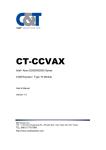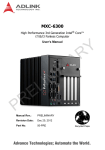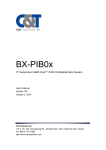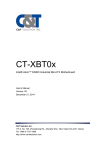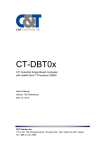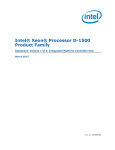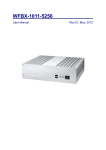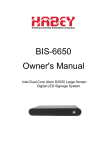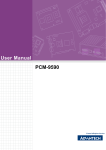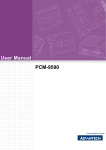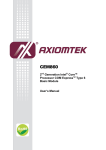Download Evido EAD-D2000 User`s manual
Transcript
CT-CCV6X Intel® Atom D2000/N2000 Series COM Express™ Type 6 Module User’s Manual Version 1.0 C&T Solution Inc. 12F. -1, No.700, Zhongzheng Rd., Zhonghe Dist., New Taipei City 235, Taiwan TEL: 886-2-77317888 http://www.candtsolution.com CT-CCV6X Intel Atom D2000/N2000 COM Express Type 6 Module Table of Contents I. Preface ..................................................................................................... 5 1.1 Disclaimer ...................................................................................... 5 1.2 Copyright Notice ............................................................................. 5 1.3 Trademarks Acknowledgment ........................................................ 5 II. Introduction.............................................................................................. 6 2.1 Product Description ........................................................................ 6 2.2 Specifications ................................................................................. 7 2.3 Block Diagram ................................................................................ 9 2.4 SKU ............................................................................................. 10 III. Mechanical Specification ..................................................................... 11 3.1 Module Dimensions ..................................................................... 11 3.2 Layout ......................................................................................... 12 3.3 Connectors .................................................................................. 14 3.3.1 LPC Debug Port: CN2 ....................................................... 14 3.3.2 CPLD JTAGE: CN3 ........................................................... 14 3.3.3 COM Express Connectors ................................................ 14 3.4 Thermal Solutions ....................................................................... 18 3.4.1 Heat Sink .......................................................................... 18 3.4.2 Heat Spreader ................................................................... 19 IV. Features & Interfaces .......................................................................... 21 Processor .................................................................................... 21 BIOS............................................................................................ 21 System Memory .......................................................................... 21 Graphics ...................................................................................... 21 4.4.1 Analog Display Port........................................................... 21 4.4.2 LVDS................................................................................. 22 4.4.3 Digital Display Interfaces (DDI) ......................................... 22 4.5 Chipset ........................................................................................ 25 4.6 USB ............................................................................................. 25 4.6.1 USB 2.0 ............................................................................. 25 4.6.1 USB 3.0 ............................................................................. 26 4.1 4.2 4.3 4.4 4.7 SATA ........................................................................................... 26 4.8 PCI Express ................................................................................ 27 4.8.1 PCI Express x1 ................................................................. 27 4.9 High Definition Audio ................................................................... 27 4.10 Ethernet..................................................................................... 28 2 CT-CCV6X Intel Atom D2000/N2000 COM Express Type 6 Module 4.11 LPC ........................................................................................... 28 SPI ............................................................................................ 29 UART ........................................................................................ 29 SMBus....................................................................................... 29 ExpressCard ............................................................................. 30 General Purpose Input Output .................................................. 30 4.16.1 GPIO Configuration ......................................................... 30 4.16.2 Registers Description ...................................................... 31 4.17 Power and System Management Signals.................................. 33 4.18 Thermal Management Signals .................................................. 34 4.19 Miscellaneous Signals ............................................................... 34 4.12 4.13 4.14 4.15 4.16 V. 4.20 Watchdog Timer ........................................................................ 35 4.20.1 Board Design .................................................................. 35 4.20.2 PSUEDO CODE.............................................................. 35 SYSTEM BIOS..................................................................................... 37 5.1 Main ............................................................................................ 37 5.2 Advanced .................................................................................... 38 5.2.1 ACPI Settings .................................................................... 39 5.2.2 Trusted Computing............................................................ 40 5.2.3 CPU Configuration ............................................................ 41 5.2.4 IDE Configuration .............................................................. 42 5.2.5 USB Configuration ............................................................ 43 5.2.6 Hardware Monitor.............................................................. 44 5.2.7 W83627DHG Super IO Configuration ............................... 45 5.2.8 Serial Port Console Redirection ........................................ 48 5.2.9 PPM Configuration ............................................................ 49 5.3 Chipset ........................................................................................ 50 5.3.1 Host Bridge ....................................................................... 51 5.3.2 South Bridge ..................................................................... 53 5.4 Boot ............................................................................................. 56 5.4.1 CSM parameters ............................................................... 57 5.5 Security ....................................................................................... 58 5.6 Save and Exit .............................................................................. 59 VI. Address Map ....................................................................................... 60 6.1 I/O Port Address Map .................................................................. 60 6.2 Interrupt Controller (IRQ) Map ..................................................... 62 6.3 Memory Map ............................................................................... 65 3 CT-CCV6X Intel Atom D2000/N2000 COM Express Type 6 Module VII. Electrical Specification ....................................................................... 66 7.1 Input Power ................................................................................. 66 4 CT-CCV6X Intel Atom D2000/N2000 COM Express Type 6 Module I. Preface 1.1 Disclaimer All specifications and information in this User’s Manual are believed to be accurate and up to date. C&T Solution Inc. does not guarantee that the contents herein are complete, true, accurate or non-misleading. The information in this document is subject to change without notice and does not represent a commitment on the part of C&T Solution Inc. C&T Solution Inc. disclaims all warranties, express or implied, including, without limitation, those of merchantability, fitness for a particular purpose with respect to contents of this User’s Manual. Users must take full responsibility for the application of the product. 1.2 Copyright Notice All rights reserved. No part of this manual may be reproduced or transmitted in any form or by any means, electronic or mechanical, including photocopying, recording, or information storage and retrieval systems, without the prior written permission of C&T Solutions Inc. Copyright © 2012 C&T Solutions Inc. 1.3 Trademarks Acknowledgment Intel®, Celeron® and Pentium® are trademarks of Intel Corporation. Windows® is registered trademark of Microsoft Corporation. AMI is trademark of American Megatrend Inc. IBM, XT, AT, PS/2 and Personal System/2 are trademarks of International Business Machines Corporation All other products and trademarks mentioned in this manual are trademarks of their respective owners. 5 CT-CCV6X Intel Atom D2000/N2000 COM Express Type 6 Module II. Introduction 2.1 Product Description The CT-CCV6X is a new COM (computer-on-module) Express® compact form factor (95x95mm) in embedded computing platforms. It combines the onboard Intel® Atom D2550/N2600 processor with Intel® NM10 Express chipset. The CT-CCV6X is based on the COM Express® specification and features a standardized connector layout that carries a specified set of signals. With the Type 6 pin-out connectors, the CT-CCV6X supports DDI/LVDS/VGA, SATA, HD audio, Gigabit Ethernet, PCIe and USB3.0. This system requires a Carrier Board to bring out I/O and power up. The benefit of this standardization pin-out is making the application design more flexible. To accommodate different ODM requirements, the COM Express module with a Carrier Board is the best cost-effective solution and reduces development time. 6 CT-CCV6X Intel Atom D2000/N2000 COM Express Type 6 Module 2.2 Specifications CPU Intel® Atom D2550 processor, 1.86GHz Intel® Atom N2600 processor, 1.6GHz Chipset Intel® NM10 PCH System Memory One 204-pin DDR3 SODIMM socket 800MHz or 1066MHz Up to 4GB at Intel® Atom D2550 processor Up to 2GB at Intel® Atom N2600 processor BIOS AMI uEFI BIOS 2MB SPI Flash ROM SSD 16GB SSD onboard TPM Trusted Platform Module compatible with TPM1.2 Infineon SLB9635 Graphics Dual display Graphic core frequency 640MHz at D2550 processor 400MHz at N2600 processor CRT interface supports up to 1920x1200 Single channel of LVDS interface 1-ch 24-bit LVDS supports resolution up to 1440x900 MHz at D2550 processor 1-ch 18-bit LVDS supports resolution up to 1366x768 MHz at N2600 processor Ethernet Intel® 82583V GbE controller Two DDI ports supports HDMI / DVI / DisplayPort / eDP One 10/100/1000 Base-Tx Audio 7 CT-CCV6X Intel Atom D2000/N2000 COM Express Type 6 Module Integrated in chipset Intel® NM10 SATA Interface One SATA 3Gb/s port Optional second SATA PCIe Lane Two PCIex1 Lane Optional third PCIex1 Lane USB Interface Eight USB 2.0 ports Four USB 3.0 ports LPC Interface SMBus SPI Interface 8-bit GPIO Watchdog Timer H/W Monitor Power Management ACPI (Advanced Configuration and Power Interface) Form Factor Compact size, 95mm x 95mm 8 CT-CCV6X Intel Atom D2000/N2000 COM Express Type 6 Module 2.3 Block Diagram VGA 1-ch 24/18-bit LVDS CPU Intel D2550/N2600 DDR3 1067MH z SODIMM Up to 4GB/2GB DDI0 (DisplayPort/HDMI) DDI1 (DisplayPort/HDMI) SATAII Port1 Selection Circuit DMI Onboard 16GB SSD Intel NM10 8xUSB2.0 PCIex1 Port3 2xPCIex1 HDA 8-bit DIO Connector ROW CD Connector ROW AB Connector ROW A,B Connector ROW AB PCH SATAII Port0 TUSB 4xUSB3.0 7340 SMBUS GbE Intel 82583V PCIex1 Port2 BIOS SPI LPC TPM CPLD Debug Port 9 CT-CCV6X Intel Atom D2000/N2000 COM Express Type 6 Module 2.4 SKU Product Number Processor PCH Features CT-CCV61 Intel Atom NM10 1xDDR3, 24-bit LVDS, 2xPCIex1, GbE, 4xUSB3.0, D2550 CT-CCV62 Intel Atom N2600 8xUSB2.0, 1xSATA, onboard 16GB SSD, TMP1.2 NM10 1xDDR3, 18-bit LVDS, 2xPCIex1, GbE, 4xUSB3.0, 8xUSB2.0, 1xSATA, onboard 16GB SSD, TMP1.2 10 CT-CCV6X Intel Atom D2000/N2000 COM Express Type 6 Module III. Mechanical Specification 3.1 Module Dimensions The PCB size of CT-CCV6X is 95mm x 95mm, the standard COM Express compact Module size. The holes shown in the drawing below is for stacking the module with the Heat Spreader / Heat Sink and the Carrier Board. The mounting holes are 2.7mm, and the 2.5mm hardware shall be used. The position and the dimension of the holes are shown in the unit of millimeters. Top View: 11 CT-CCV6X Intel Atom D2000/N2000 COM Express Type 6 Module Side View and Bottom View: 3.2 Layout There is one SODIMM socket mounted on the top side of the CT-CCV6X. Two 220-pin COM Express connectors are mounted at the bottom side of the PCB. 12 CT-CCV6X Intel Atom D2000/N2000 COM Express Type 6 Module Top View: CN1 CN2 CN3 Bottom View: CN4 CN5 13 CT-CCV6X Intel Atom D2000/N2000 COM Express Type 6 Module 3.3 Connectors Connector CN1 CN2 CN3 CN4 CN5 3.3.1 Description SODIMM Socket LPC Debug Port CPLD JTAGE COM™ Express connector Row A, B COM™ Express connector Row C, D LPC Debug Port: CN2 Pin Signal Pin Signal 1 GND 2 3.3V 3 LPC_AD3 4 BIOS_DIS0-L 5 LPC_AD2 6 RESET 7 LPC_AD1 8 CLOCK 9 LPC_AD0 10 FRAME 3.3.2 CPLD JTAGE: CN3 Pin Signal Pin Signal 1 3.3V 2 GND 3 TDO 4 GND 5 TDI 6 GND 7 TMS 8 GND 9 TCK 10 GND 3.3.3 COM Express Connectors The CT-CCV6X is connected to the carrier board via two 220-pin connectors. Each connector is break down into two rows. The first connector, CN4, consists Row A and Row B; the second connector, CN5, consists Row C and Row D. Their pin-out is as table below. 14 CT-CCV6X Intel Atom D2000/N2000 COM Express Type 6 Module Pin Row A Row B Row C Row D 1 GND(FIXED) GND(FIXED) GND(FIXED) GND(FIXED) 2 GBE0_MDI3- GBE0_ACT# GND GND 3 GBE0_MDI3+ LPC_FRAME# USB_SSRX0- USB_SSTX0- 4 GBE0_LINK100# LPC_AD0 USB_SSRX0+ USB_SSTX0+ 5 GBE0_LINK1000# LPC_AD1 GND GND 6 GBE0_MDI2- LPC_AD2 USB_SSRX1- USB_SSTX1- 7 GBE0_MDI2+ LPC_AD3 USB_SSRX1+ USB_SSTX1+ 8 GBE0_LINK# LPC_DRQ0# GND GND 9 GBE0_MDI1- LPC_DRQ1# USB_SSRX2- USB_SSTX2- 10 GBE0_MDI1+ LPC_CLK USB_SSRX2+ USB_SSTX2+ 11 GND(FIXED) GND(FIXED) GND(FIXED) GND(FIXED) 12 GBE0_MDI0- PWRBTN#- USB_SSRX3- USB_SSTX3- 13 GBE0_MDI0+ SMB_CK USB_SSRX3+ USB_SSTX3+ 14 GBE0_CTREF SMB_DAT GND GND 15 SUS_S3# SMB_ALERT# NC DDI1_CTRLCLK_AUX+ 16 SATA0_TX+ SATA1_TX+(Reserved) NC DDI1_CTRLDATA_AUX- 17 SATA0_TX- SATA1_TX-(Reserved) NC NC +CTRLDATA_AUX- 18 SUS_S4# SUS_STAT# NC NC 19 SATA0_RX+ SATA1_RX+(Reserved) NC NC 20 SATA0_RXS SATA1_RX-(Reserved) NC NC 21 GND(FIXED) GND(FIXED) GND(FIXED) GND(FIXED) 22 NC NC NC NC 23 NC NC - NC NC 24 SUS_S5# PWR_OK DDI1_HPD NC 25 NC NC NC NC 26 NC NC - NC DDI1_PAIR0+ 27 BATLOW# WDT NC DDI1_PAIR0- 28 (S)ATA_ACT# AC/HAD_SDIN2 NC NC 29 AC/HDA_SYNC AC/HAD_SDIN1 NC DDI1_PAIR1+ 30 AC/HAD_RST# AC/HAD_SDIN0 NC DDI1_PAIR1- 31 GND(FIXED) GND(FIXED) GND(FIXED) GND(FIXED) 32 AC/HDA_BITCLK SPKR DDI2_CTRLCLK_AUX+ DDI1_PAIR2+ 33 AC/HAD_SDOUT I2C_CK DDI2_ DDI1_PAIR2- 34 BIOS_DIS0# I2C_DAT DDI2_DDC_AUX_SEL CTRLDATA_AUX- DDI1_DDC_AUX_SEL 35 THRMTRIP# THRM# NC NC 36 USB6- USB7- NC DDI1_PAIR3+ 37 USB6+ USB7+ NC DDI1_PAIR3- 38 USB_6_7_OC# USB_4_5_OC# NC NC 15 CT-CCV6X Intel Atom D2000/N2000 COM Express Type 6 Module Pin Row A Row B Row C Row D 39 USB4- USB5- NC DDI2_PAIR0+ 40 USB4+ USB5+ NC DDI2_PAIR0- 41 GND(FIXED) GND(FIXED) GND(FIXED) GND(FIXED) 42 USB2- USB3- NC DDI2_PAIR1+ 43 USB2+ USB3+ NC DDI2_PAIR1- 44 USB_2_3_OC# USB_0_1_OC# NC DDI2_HPD 45 USB0- USB1- NC NC 46 USB0+ USB1+ NC DDI2_PAIR2+ 47 VCC_RTC EXCD1_PERST# NC DDI2_PAIR2- 48 EXCD0_PERST# EXCD1_CPPE# NC NC 49 EXCD0_CPPE# SYS_RESET# NC DDI2_PAIR3+ 50 LPC_SERIRQ CB_RESET# NC DDI2_PAIR3- 51 GND(FIXED) GND(FIXED) GND(FIXED) GND(FIXED) 52 NC NC NC NC 53 NC NC NC NC 54 GPI0 GPO1 NC NC 55 NC NC NC NC 56 NC NC NC NC 57 GND GPO2 NC GND 58 NC NC NC NC 59 NC NC NC NC 60 GND(FIXED) GND(FIXED) GND(FIXED) GND(FIXED) 61 PCIE2_TX+ PCIE2_RX+ NC NC 62 PCIE2_TX- PCIE2_RX- NC NC 63 GPI1 GPO3 NC NC 64 PCIE1_TX+ PCIE1_RX+ NC NC 65 PCIE1_TX- PCIE1_RX- NC NC 66 GND WAKE0# NC NC 67 GPI2 WAKE1# NC GND 68 PCIE0_TX+ PCIE0_RX+ NC NC 69 PCIE0_TX- PCIE0_RX- NC NC 70 GND(FIXED) GND(FIXED) GND(FIXED) GND(FIXED) 71 LVDS_A0+ NC NC NC 72 LVDS_A0- NC NC NC 73 LVDS_A1+ NC GND GND 74 LVDS_A1- NC NC NC 75 LVDS_A2+ NC NC NC 76 LVDS_A2- NC GND GND 16 CT-CCV6X Intel Atom D2000/N2000 COM Express Type 6 Module Pin Row A Row B Row C Row D 77 LVDS_VDD_EN NC NC NC 78 LVDS_A3+ NC NC NC 79 LVDS_A3- LVDS_BKLT_EN NC NC 80 GND(FIXED) GND(FIXED) GND(FIXED) GND(FIXED) 81 LVDS_A_CK+ NC NC NC 82 LVDS_A_CK- NC NC NC 83 LVDS_I2C_CK LVDS_BKLT_CTRL NC NC 84 LVDS_I2C_DAT VCC_5V_SBY GND GND 85 GPI3 VCC_5V_SBY NC NC 86 NC VCC_5V_SBY NC NC 87 NC VCC_5V_SBY GND GND 88 PCIE_CK_REF0+ BIOS_DIS1# NC NC 89 PCIE_CK_REF0- VGA_RED NC NC 90 GND(FIXED) GND(FIXED) GND(FIXED) GND(FIXED) 91 SPI_POWER VGA_GRN NC NC 92 SPI_MISO VGA_BLU NC NC 93 GPO0 VGA_HSYNC GND GND 94 SPI_CLK VGA_VSYNC NC NC 95 SPI_MOSI VGA_I2C_CK NC NC 96 TPM_PP VGA_I2C_DAT GND GND 97 NC SPI_CS# NC NC 98 SER0_TX NC NC NC 99 SER0_RX NC NC NC 100 GND(FIXED) GND(FIXED) GND(FIXED) GND(FIXED) 101 SER1_TX FAN_PWMOUT NC NC 102 SER1_RX FAN_TACHIN NC NC 103 LID# SLEEP# GND GND 104 VCC_12V VCC_12V VCC_12V VCC_12V 105 VCC_12V VCC_12V VCC_12V VCC_12V 106 VCC_12V VCC_12V VCC_12V VCC_12V 107 VCC_12V VCC_12V VCC_12V VCC_12V 108 VCC_12V VCC_12V VCC_12V VCC_12V 109 VCC_12V VCC_12V VCC_12V VCC_12V 110 GND(FIXED) GND(FIXED) GND(FIXED) GND(FIXED) 17 CT-CCV6X Intel Atom D2000/N2000 COM Express Type 6 Module 3.4 Thermal Solutions There are two thermal solutions for the COM Express Module CT-CCV6X to dissipate the heat. One is by using a heat sink and the other one is by using a heat spreader. 3.4.1 Heat Sink Step 1: Connect the COM Express connectors on the module, CT-CCV6X, to the corresponding COM connectors on the Carrier Board. Make sure the four holes at the corners of CT-CCV6X module align to the corresponding pillars on the Carrier Board. Step2: Place the heat sink on top of the CT-CCV6X module. Step3: Use four screws (M2.5x15L) to secure the heat sink with the Carrier Board through the corresponding holes on the CT-CCV6X. 18 CT-CCV6X Intel Atom D2000/N2000 COM Express Type 6 Module 3.4.2 Heat Spreader A heat spreader is designed for the CT-CCV6X to dissipate heat. All heat generating components are thermally conducted to the heat spreader in order to avoid hot spots. The assembly of the heat spreader with CT-CCV6X module and the Carrier board is same as the heat sink. Step 1: Connect the COM Express connectors on the module, CT-CCV6X, to the corresponding COM connectors on the Carrier Board. Make sure the four holes at the corners of CT-CCV6X module align to the corresponding pillars on the Carrier Board. Step2: Place the heat spreader on top of the CT-CCV6X module. Step3: Use four screws (M2.5x15L) to secure the heat sink with the Carrier Board through the corresponding holes on the CT-CCV6X. 19 CT-CCV6X Intel Atom D2000/N2000 COM Express Type 6 Module 20 CT-CCV6X Intel Atom D2000/N2000 COM Express Type 6 Module IV. Features & Interfaces 4.1 Processor The CT-CCV6X supports Intel® Atom D2550/N2600 processor. This 64-bit and multi-core mobile processor built on 32-nanometer process technology is based on a new micro-architecture. This architecture consists a processor and Platform Controller Hub (PCH) to form a two-chip platform. The processor includes Integrated Display Engine, Processor Graphics and Integrated Memory Controller. 4.2 BIOS The AMI uEFI BIOS, 2MB SPI Flash Rom is used in the CT-CCV6X module. 4.3 System Memory The Integrated Memory Controller (IMC) of the processor supports one 64-bit channel of DDR3 protocols. The channel allows the data transfer rate of 800/1066MHz with a 204-pin SODIMM socket. The maximum memory size of the SODIMM socket is 4GB supported by Intel Atom D2550 on the CT-CCV6X; 2GB supported by Intel Atom N2600. 4.4 Graphics Intel Atom Processor D2550 and N2600 contain an integrated graphics engine, video decode and a display controller that supports two pipes to LVDS, CRT, HDMI/DVI, DP, eDP. The graphic core frequency is 640 MHz at D2550 and 400 MHz at N2600. 4.4.1 Analog Display Port The Analog Port provides a RGB signal output along with a HSYNC and VSYNC signal. There is an associated Display Data Channel (DDC) signal pair that is implemented using GPIO pins dedicated to the analog port. The intended target device is for a CRT Based monitor with a VGA connector. The Analog Port can directly drive a standard progressive scan analog monitor up to a resolution of 1920x1200 pixels with 32-bit color at 60Hz. 21 CT-CCV6X Intel Atom D2000/N2000 COM Express Type 6 Module 4.4.2 Signal I/O Description VGA_RED O VGA_GRN O VGA_BLU O VGA_HSYNC O Red for monitor, analog DAC output, designed to drive a 37.5Ω equivalent load. Green for monitor, analog DAC output, designed to drive a 37.5Ω equivalent load. Blue for monitor, analog DAC output, designed to drive a 37.5Ω equivalent load. Horizontal sync output to VGA monitor VGA_VSYNC O Vertical sync output to VGA monitor VGA_I2C_CLK I/O Monitor clock line VGA_I2C_DATA I/O Monitor data line LVDS The LVDS transmitter channel of D2550 consists of 4 data pairs and a clock pair; N2600 consists of 3 data pairs and a clock pair. The LVDS data pair is used to transfer pixel data as well as the LCD timing control signals. The maximum resolution is 1440x900 at D2550 CPU and 1366x768 at N2600 CPU. 4.4.3 Signal I/O Description LVDS_A[3:0]+ O LVDS_A[3:0]- O LVDS_A_CLK+ O Differential data output - positive LVDS_A3+ support at D2550 only Differential data output – negative LVDS_A3- support at D2550 only Differential clock output - positive LVDS_A_CLK- O Differential clock output - negative LVDS_VDD_EN O LVDS panel power enable LVDS_BKLT_EN O Panel backlight enable control LVDS_BKLT_CTR O Panel backlight brightness control LVDS_I2C_CLK I/O LVDS_I2C_DATA I/O LVDS flat panel I2C clock for EDID read and control. LVDS flat panel I2C data for EDID read and control. Digital Display Interfaces (DDI) The Intel Atom Processor D2550 and N2600 can drive HDMI, DVI, eDP and Display Port natively. Its two display ports can support up to two different images on two different display devices. 22 CT-CCV6X Intel Atom D2000/N2000 COM Express Type 6 Module Signal I/O Description DDI[1:2]_PAIR[0:3]+ O DDI 1 and 2 Pair[0:3] differential pairs DDI[1:2]_PAIR[0:3]Selects the function of DDI[1:2]_CTRLCLK_AUX+ and DDI[1:2]_CTRLDATA_AUX-. This pin shall have a 1M pull-down to logic ground on the Module. If this input is floating the AUX pair is used for the DP AUX+/- signals. If pulled-high the AUX pair contains the CTRLCLK and CTRLDATA signals. DP AUX+ function if DDI[1:2]_DDC_AUX_SEL is no connect HDMI/DVI I2C CTRLCLK if DDI[1:2]_DDC_AUX_SEL is pulled high DP AUX- function if DDI[1:2]_DDC_AUX_SEL is no connect HDMI/DVI I2C CTRLDATA if DDI[1:2]_DDC_AUX_SEL is pulled high DDI Hot-Plug Detect DDI[1:2]_DDC_AUX_SEL I DDI[1:2]_CTRLCLK_AUX+ I/O I/O DDI[1:2]_CTRLDATA_AUX- I/O I/O DDI[1:2]_HPD I Signal Pin eDP/DP HDMI/DVI DDI1_PAIR0+ D26 DP1_LANE0+ TMDS1_DATA2+ DDI1_PAIR0- D27 DP1_LANE0- TMDS1_DATA2- DDI1_PAIR1+ D29 DP1_LANE1+ TMDS1_DATA1+ DDI1_PAIR1- D30 DP1_LANE1- TMDS1_DATA1- DDI1_PAIR2+ D32 DP1_LANE2+ TMDS1_DATA0+ DDI1_PAIR2- D33 DP1_LANE2- TMDS1_DATA0- DDI1_PAIR3+ D36 DP1_LANE3+ TMDS1_CLK+ DDI1_PAIR3- D37 DP1_LANE3- TMDS1_CLK- DDI1_CTRLCLK_AUX+ D15 DP1_AUX+ TMDS1_SCL DDI1_CTRLDATA_AUX- D16 DP1_AUX- TMDS1_SDA DDI1_DDC_AUX_SEL D34 CONFIG1 (pull down to GND) Pull up to 5V DDI1_HPD (3.3V active high signal) C24 Signal Pin DP HDMI/DVI DDI2_PAIR0+ D39 DP2_LANE0+ TMDS2_DATA2+ DDI2_PAIR0- D40 DP2_LANE0- TMDS2_DATA2- DDI DDI2_PAIR1+ D42 DP2_LANE1+ TMDS2_DATA1+ 2 DDI2_PAIR1- D43 DP2_LANE1- TMDS2_DATA1- DDI2_PAIR2+ D46 DP2_LANE2+ TMDS2_DATA0+ DDI2_PAIR2- D47 DP2_LANE2- TMDS2_DATA0- DDI 1 23 CT-CCV6X Intel Atom D2000/N2000 COM Express Type 6 Module DDI2_PAIR3+ D49 DP2_LANE3+ TMDS2_CLK+ DDI2_PAIR3- D50 DP2_LANE3- TMDS2_CLK- DDI2_CTRLCLK_AUX+ C32 DP2_AUX+ HDMI2_SCL DDI2_CTRLDATA_AUX- C33 DP2_AUX- HDMI2_SDA DDI2_DDC_AUX_SEL C34 CONFIG1 (pull down to GND) Pull up to 5V DDI2_HPD (3.3V active high signal) D44 4.4.3.1 High Definition Multimedia Interface (HDMI) The HDMI is provided for transmitting uncompressed digital audio and video signals to television sets, projectors and other video displays. 4.4.3.2 Digital Video Interface (DVI) The PCH digital ports can be configured to drive DVI-D. DVI uses TMDS for transmitting data from the transmitter to the receiver, which is similar to the HDMI protocol but the audio and CEC. When a system has support for DVI-I port, then either VGA or the DVI-D through a single DVI-I connector can be driven but not both simultaneously. The HDMI or DVI supports the resolution up to 1920x1200 at 60Hz. HDMI Signal I/O Description TMDS[1:2]_CLK+ O HDMI/DVI TMDS Clock differential pair O HDMI/DVI TMDS lanes 0, 1 and 2 differential pairs HDMI[1:2]_SCL I/O HDMI/DVI I2C control clock HDMI[1:2]_SDA I/O HDMI/DVI I2C control data TMDS[1:2]_CLKTMDS[1:2]_DATA[0:2]+ TMDS[1:2]_DATA[0:2]- 4.4.3.3 Display Port (DP) The Display Port is a digital communication interface that utilized differential signaling to achieve a high bandwidth bus interface designed to support connections between PCs and monitors, projectors, and TV displays. The Display Port supports the resolution up to 2560x1600 at D2550 CPU and 1600x1200 at N2600 CPU. 24 CT-CCV6X Intel Atom D2000/N2000 COM Express Type 6 Module 4.4.3.4 Embedded DisplayPort (eDP) Embedded DisplayPort (eDP) is an embedded version of the DisplayPort standard oriented towards applications such as notebook and All-In-One PCs. eDP is supported only on Digital Display Port 1. The resolution is up to 1920x1080 at D2550 CPU and 1366x768 at N2600 CPU. DP Signal I/O Description DP[1:2]_LANE[0:3]+ O Uni-directional main link for the transport of isochronous streams and secondary-data packets Half-duplex bi-directional AUX channel for services such as link configuration or maintenance and EDID access DP[1:2]_LANE[0:3]DP[1:2]_AUX+ I/O DP[1:2]_AUX- 4.5 Chipset The Platform Controller Hub (PCH) used on CT-CCV6X is Intel NM10. The PCH provides extensive I/O support with two COM™ Express connectors. 4.6 USB 4.6.1 USB 2.0 The two EHCI Controllers of Intel® NM10 offer eight USB2.0 ports. Each USB2.0 port supports USB 1.1 and 2.0 compliant devices. Signal I/O Description USB[0:7]+ I/O USB differential pairs, channels 0 through 7 USB_0_1_OC# I USB_2_3_OC# I USB_4_5_OC# I USB over-current sense, USB 0 and 1. A pull-up for this line shall be present on the Module. An open drain driver from a USB current monitor on the Carrier Board may drive this line low. Do not pull this line high on the Carrier Board. USB over-current sense, USB 2 and 3. A pull-up for this line shall be present on the Module. An open drain driver from a USB current monitor on the Carrier Board may drive this line low. Do not pull this line high on the Carrier Board. USB over-current sense, USB 4 and 5. A pull-up for this line shall be present on the Module. An open drain driver from a USB current monitor on the Carrier Board may drive this line low. Do not pull this line high on the Carrier Board. USB[0:7]- 25 CT-CCV6X Intel Atom D2000/N2000 COM Express Type 6 Module 4.6.1 Signal I/O Description USB_6_7_OC# I USB over-current sense, USB 6 and 7. A pull-up for this line shall be present on the Module. An open drain driver from a USB current monitor on the Carrier Board may drive this line low. Do not pull this line high on the Carrier Board. USB 3.0 There are four USB 3.0 ports by extended from the Port 3 of the PCIe x1 interface. Signal I/O Description USB_SSRX[0:3]+ I USB differential pairs, channels 0 through 3, receive Data/Address/Command signals I USB differential pairs, channels 0 through 3, transmit Data/Address/Command signals USB_SSRX[0:3]USB_SSTX[0:3]+ USB_SSTX[0:3]- 4.7 SATA The PCH NM10 provides two Serial ATA (SATA) ports. The Port 0 and 1 support SATA 3.0 Gb/s device transfers. This interface may be used for Serial Attached SCSI (SAS). Signal I/O Description SATA0_TX+ SATA0_TXSATA0_RX+ SATA0_RXSATA1_TX+ SATA1_TXSATA1_RX+ SATA1_RX- O Serial ATA 0 transmit differential pair I Serial ATA 0 receive differential pair O Serial ATA 1 transmit differential pair (reserved) I Serial ATA 1 receives differential pair (reserved) (S)ATA_ACT# OC ATA (parallel and serial) activity indicator, active low The SATA Port 0 of CT-CCV6X can be used for general SATA devices. The SATA Port 1 of CT-CCV6X has been used for onboard 16GB SSD. Also, this interface has been reserved on the COM Express connector Row B. When the onboard SSD of CT-CCV6X is not applied, the interface on the COM Express connector could be used for general SATA devices. 26 CT-CCV6X Intel Atom D2000/N2000 COM Express Type 6 Module 4.8 PCI Express 4.8.1 PCI Express x1 There are four one-lane PCI Express ports available in the PCH NM10. The ports are compliant to the PCI Express 1.0 specification running at 2.5 Gb/s. Only two PCIe x1 Ports, 0~1, are left on the CT-CCV6X COM™ Express connector since Port 2 is occupied by GbE and Port 3 is occupied by USB3.0. Signal I/O Description PCIE[0:1]_TX+ O PCI Express Differential transmit Pairs 0 through 1 I PCI Express Differential receive Pairs 0 through 1 O Reference clock output for all PCI Express and PCI Express Graphics lanes PCIE[0:1]_TXPCIE[0:1]_RX+ PCIE[0:1]_RXPCIE_CK_REF0+ PCIE_CK_REF0- 4.9 High Definition Audio The High Definition Audio (HDA) controller is integrated with PCH NM10. It communicates with the external codec(s) over the Intel® High Definition Audio serial link. The controller consists of a set of DMA engines that are used to move samples of digitally encoded data between system memory and an external codec(s). The PCH implements a single Serial Data Output signal (HDA_SDOUT) that is connected to all external codecs. Three Serial Digital Input signals (HDA_SDIN[2:0]) provided by the PCH support up to three codecs. Signal I/O Description AC/HDA_RST# O Reset output to CODEC, active low AC/HDA_SYNC O Sample-synchronization signal to the CODEC(s) AC/HDA_BITCLK O AC/HDA_SDOUT O Serial data clock generated by the external CODEC(s) Serial TDM data output to the CODEC AC/HDA_SDIN[2:0] I/O Serial TDM data input from up to 3 CODECs 27 CT-CCV6X Intel Atom D2000/N2000 COM Express Type 6 Module 4.10 Ethernet The Intel® 82583V, a fully-integrated Gigabit Ethernet Media Access Control (MAC) provides 10/100/1000Mb/s Ethernet interface. The Intel® 82583V is connected to Port 2 of the PCIe x1 in the PCH. Gigabit transformer has to be designed on the Carrier Board. The integrated GbE controller contains power management registers for PCIE, so it supports the Advanced Configuration and Power Interface (ACPI) specification. This enables the network-related activity (using an internal host wake signal) to wake up the host. Signal I/O Description GBE0_MDI[0:3]+ I/O Gigabit Ethernet Controller 0: Media Dependent Interface Differential Pairs 0, 1, 2, 3. The MDI can operate in 1000, 100 and 10 Mbit/sec modes. Some pairs are unused in some modes, per the following: GBE0_MDI[0:3]- MDI[0]+/MDI[1]+/MDI[2]+/MDI[3]+/- GBE0_ACT# OD GBE0_LINK# OD GBE0_LINK100# OD GBE0_LINK1000# OD GBE0_CTREF REF 1000BASE-T B1_DA+/B1_DB+/B1_DC+/B1_DD+/- 100BASE-TX TX+/RX+/- 10BASE-T TX+/RX+/- Gigabit Ethernet Controller 0 activity indicator, active low Gigabit Ethernet Controller 0 link indicator, active low Gigabit Ethernet Controller 0 100 Mbit/sec link indicator, active low Gigabit Ethernet Controller 0 1000 Mbit/sec link indicator, active low Reference voltage for Carrier Board Ethernet channel 0 magnetics center tap. The reference voltage is 3.3V. 4.11 LPC The LPC interface provides legacy I/O support on a Carrier Board via a Super I/O and system management devices. Signal I/O Description LPC_AD[3:0] I/O LPC multiplexed address, command and data LPC_FRAME# O LPC frame indicates the start of an LPC cycle LPC_DRQ[0:1]# I LPC serial DMA request input 28 CT-CCV6X Intel Atom D2000/N2000 COM Express Type 6 Module Signal I/O Description LPC_SERIRQ I/O LPC serial interrupt LPC_CLK O LPC clock output – 33MHz nominal 4.12 SPI The Serial Peripheral Interface (SPI) is a 4-pin interface that supports SPI-compatible flash devices. The SPI flash device can be up to 16MB (128Mb). The SPI bus is clocked at either 20MHz, 25MHz, 33MHz or 50 MHz. SPI devices selected should support one of these frequencies. Signal I/O Description SPI_CS# O SPC_MISO I Chip select for Carrier Board SPI - may be sourced from chipset SPI0 or SPI1 Data in to Module from Carrier SPI SPI_MISI O Data out from Module to Carrier SPI SPI_CLK O Clock from Module to Carrier SPI SPI_POWER O Power supply for Carrier Board SPI – sourced from Module – nominally 3.3V. The Module shall provide a minimum of 100mA on SPI_POWER. Carriers shall use less than 100ma of SPI_POWER. SPI_POWER shall only be used to power SPI devices on the Carrier Board. 4.13 UART The CT-CCV6X module supports two serial RX/TX ports. Signal I/O Description SER[0:1]_TX O UART transmitter SER[0:1]_RX I UART receiver 4.14 SMBus The SMBus port is specified for system management functions. It is used on the Module to manage system function such as reading the DRAM SPD EEPROM and setting clock synthesizer parameters. If the SMBus is used on the carrier board, then great care must be taken that no conflicts with the on-Module SMBus devices occur. It may be useful for implementation on the 29 CT-CCV6X Intel Atom D2000/N2000 COM Express Type 6 Module Carrier Board of standards such as Smart Battery. The maximum capacitance on the Carrier Board shall not exceed 100pF. Signal I/O Description SMB_CK I/OD System Management Bus bidirectional clock line SMB_DAT I/OD System Management Bus bidirectional data line SMB_ALERT# I System Management Bus Alert – active low input can be used to generate an SMI# (System Management Interrupt) or to wake the system. 4.15 ExpressCard ExpressCard is a small form factor expansion card that uses PCI Express or USB as the interface. It is similar in concept and scope to CardBus. The CT-CCV6X supports two Express Card interface. Signal I/O Description EXCD[0:1]_CPPE# I EXCD[0:1]_PERST# O PCI ExpressCard: PCI Express capable card request, active low, one per card PCI ExpressCard: reset, active low, one per card 4.16 General Purpose Input Output GPI and GPO pins may be implemented as GPIO (Module specific). GPI and GPO pins may be implemented as SDIO. Signal I/O Description GPO[0:3] O GPI[0:3] I General purpose output pins. Upon a hardware reset, these outputs should be low General purpose input pins. Pulled high internally on the Module. 4.16.1 GPIO Configuration Output Pin default setting is HIGH. Pin # GPIO# Default Configuration B63 GPIO7 GPO3 B57 GPIO6 GPO2 B54 GPIO5 GPO1 30 CT-CCV6X Intel Atom D2000/N2000 COM Express Type 6 Module Pin # GPIO# Default Configuration A93 GPIO4 GPO0 A85 GPIO3 GPI3 A67 GPIO2 GPI2 A63 GPIO1 GPI1 A54 GPIO0 GPI0 The GPIO function, provided by Intel Tiger Point NM10, can be accessed through GPIO Base Address Register (GPIOBASE). The configuration on CT-CCV6X is described as below. Register Address GPIOBASE Base Address 0x500 The general I/O read/write function is used to access and configure the NM10. Through the I/O read or write command, the current status of GPIO can configure each pin to input or output. 4.16.2 Registers Description 4.16.2.1 GPIO Use Select Register 1 (Offset GPIOBASE+0x00) Bit 7 Bit 6 Bit 5 Bit 4 Bit 3 Bit 2 GPIO3 GPIO2 GPIO1 GPIO0 Bit 1 Bit 0 GPIO Use Select Register 2 (Offset GPIOBASE+0x30) Bit 7 Bit 6 GPIO7 GPIO6 Bit 5 Bit 4 Bit 3 Bit 2 Bit 1 GPIO5 GPIO4 Bit 0 Bit X = 0 means Native Function Bit X = 1 means GPIO Function 4.16.2.2 GPIO Input/Output Select Register 1 (Offset GPIOBASE+0x04) Bit 7 Bit 6 Bit 5 Bit 4 Bit 3 Bit 2 GPIO3 GPIO2 GPIO1 GPIO0 Bit 1 Bit 0 31 CT-CCV6X Intel Atom D2000/N2000 COM Express Type 6 Module GPIO Input/Output Select Register 2 (Offset GPIOBASE+0x34) Bit 7 Bit 6 GPIO7 GPIO6 Bit 5 Bit 4 Bit 3 Bit 2 Bit 1 GPIO5 GPIO4 Bit 0 Bit X = 0 means Output Pin Bit X = 1 means Input Pin 4.16.2.3 GPIO Level for Input or Output Register 1 (Offset GPIOBASE+0x0C) If Pin X is configured as output, the output value (0 or 1) could be selected by user. If it is programmed as an input, this register reflects the state of the input signal. Bit 7 Bit 6 Bit 5 Bit 4 Bit 3 Bit 2 Bit 1 Bit 0 GPIO3 GPIO2 GPIO1 GPIO0 Bit 2 Bit 1 Bit 0 GPIO5 GPIO4 GPIO Level for Input or Output Register 1 (Offset GPIOBASE+0x38) Bit 7 Bit 6 GPIO7 GPIO6 Bit 5 Bit 4 Bit 3 4.16.2.4 GPIO Signal Invert Register (Offset 0x2C) It will invert the polarity of the Input Port register data. Bit 7 Bit 6 Bit 5 Bit 4 Bit 3 Bit 2 GPIO3 GPIO2 GPIO1 GPIO0 Bit 1 Bit 0 Bit X = 0 means Polarity is retained Bit X = 1 means Polarity is inverted [Note] The GPIO4~GPIO7 can’t be set to inverted. 32 CT-CCV6X Intel Atom D2000/N2000 COM Express Type 6 Module 4.16.2.5 PSUEDO CODE Example 1 Change GPIO2 from output to input Step1: ByteData = ReadIOByte(0x504) Step2: ByteData = ByteData | Bit 4 Step3: WriteIOByte(0x504, ByteData) //Read current setting from configuration register //Set Bit4 1. It means input //Write back to configuration register Example2 Set GPIO3 to output LOW Step1: ByteData = ReadIOByte(0x50C) Step2: ByteData =ByteData & 0xDF Step3: WriteIOByte(0x50C, ByteData) Register //Read current setting from Output Port register //Set Bit5 0. It means output low //Write back to Output Port 4.17 Power and System Management Signals Signal I/O Description SUS_S3# O SUS_S4# O SUS_S5# O Indicates system is suspended to RAM state. Active low output. Indicates system is suspended to Disk state. Active low output. Indicates system is in Soft Off state. SUS_STAT# O Indicates imminent suspend operation. PWRBTN# I PWR_OK I Power button to bring system out of S5 (soft off), active on rising edge. Power OK from main power supply BATLOW# I Indicates that external battery is low. SYS_RESET# I Reset button input. Active low input. CB_RESET# O Carrier Board Reset. Active low input. WAKE0# I PCI Express wake up signal. WAKE1# I General purpose wake up signal. VCC_RTC I RTC External Battery LID# I LID switch SLEEP# I Sleep Button FAN_PWMOUT O FAN PWM out FAN_TACHIN I Fan Tacho in 33 CT-CCV6X Intel Atom D2000/N2000 COM Express Type 6 Module 4.18 Thermal Management Signals Signal I/O Description THRMTRIP# O THRM# I Active low output indicating that the CPU has entered thermal shutdown. Input from off-module temp sensor indicating and over-temp situation. 4.19 Miscellaneous Signals Signal I/O Description I2C_CK O General purpose I2C port clock output I2C_DAT I/O General purpose I2C port data I/O lin WDT O Indicator for Watchdog Timeout SPKR O Output for audio enunciator-the “speaker” in PC-AT systems Signal I/O Description BIOS_DIS0# I Selection straps to determine the BIOS boot device. The Carrier should only float these or pull them low, please refer to the table below for strapping option of BIOS disable signals. BIOS_DIS1# BIOS_DIS1# BIOS_DIS0# Chipset SPI CS1# Destination Chipset SPI CS0# Destination Carrier SPI_CS# SPI Descriptor BIOS Entry Ref Line 1 1 Module Module High Module SPI0/SPI1 0 1 0 Module Module High Module CarrierFWH 1 0 1 Module Carrier SPI0 Carrier SPI0/SPI1 2 0 0 Carrier Module SPI1 Module SPI1/SPI1 3 34 CT-CCV6X Intel Atom D2000/N2000 COM Express Type 6 Module 4.20 Watchdog Timer Enable TCO Timer Reboot Function Set Initial Value into Timer Register Reload Timer Value into Register Start to Count 4.20.1 Board Design The WDT (Watchdog Timer) is implemented by using TCO function in NM10. Register Address TCO I/O Base (TCOBASE) 0x460 RCBA Memory Base (RCBA) 0xFED1C000 Notes: 1. 2. TCO (Total Cost of Ownership) RCBA (Root Complex Base Address) 4.20.2 PSUEDO CODE Step1 Enable TCO Timer Reboot Function Target: Clear RCBA+3410h Bit 5 to 0 Step1: DWordData = ReadMemoryDword(0xFED1F410) //0xFED1C000+0x3410 Step2: DWordData = DWordData & 0xFFFFFFDF //Clear DWordData Bit 5 to 0 Step3: WriteMemoryDWord(0xFED1F410, DWordData) //Write back to memory Note: 35 CT-CCV6X Intel Atom D2000/N2000 COM Express Type 6 Module The system will be rebooted after user’s setting +2 seconds. 2 seconds added is Intel’s limitation. Step2 Set Initial Value into Timer Register Target: Set TCO Timer Initial Value (Offset 0x12) Step1: WordData = ReadIOWord(0x472) //0x460+0x12 Step2: WordData = Set Bit[9:0] //0x000~0xFFF. 1 ticks = 0.6s Step3: WriteIOWord(0x472,WordData) //Write back to IO Example: If you want to reboot after 5 seconds, you should set WordData to 0x05. 5-2=3 //5 minus system’s default 2 seconds leaves the real setting data. 3 / 0.6 = 5 //5 ticks Step3 Reload Timer Value into Register Target: Reload Timer Initial Value to TCO_RLD Register (Offset 0x00) Step1: WriteIOWord(0x460, 0x01) //Reload Timer Step4 Start to Count Target: Enable Time to count (Offset 0x08) Step1: WordData = ReadIOWord(0x468) //0x460+0x08 Step2: WordData = WordData & 0xF7FF //Enabled to count Step3: WriteIOWord(0x468, WordData) // Write back to IO 36 CT-CCV6X Intel Atom D2000/N2000 COM Express Type 6 Module V. SYSTEM BIOS The system BIOS software is stored on EEPROM. The BIOS provides an interface to modify the configuration. When the battery is removed, all the parameters will be reset. Turn on the computer and press <DEL> or <F2> to enter the setup screens. 5.1 Main The Main setup screen is showed as following when the setup utility is entered. System Date/Time is set up in the Main Menu. System Language: Choose the system default language System Date: MM/DD/YYYY. Set the Date. Use Tab to switch between Date elements. System Time: HH:MM:SS. Set the Time. Use Tab to switch between Time elements. 37 CT-CCV6X Intel Atom D2000/N2000 COM Express Type 6 Module 5.2 Advanced Launch PXE OpROM : Enable or Disable Boot Option for Legacy Network Devices. 38 CT-CCV6X Intel Atom D2000/N2000 COM Express Type 6 Module 5.2.1 ACPI Settings Enable ACPI Auto Configuration: Enable or Disable BIOS ACPI Auto Configuration. ACPI Sleep State: Select the highest ACPI sleep state the system will enter when the SUSPEND button is pressed. Select between [Suspend Disabled], [S1 (CPU Stop Clock)] and [S3 (Suspend to RAM)]. 39 CT-CCV6X Intel Atom D2000/N2000 COM Express Type 6 Module 5.2.2 Trusted Computing Security Device Support enables or disables BIOS support for security device. O.S. will not show Security Device. TCG EFI protocol and INT1A interface will not be available. 40 CT-CCV6X Intel Atom D2000/N2000 COM Express Type 6 Module 5.2.3 CPU Configuration Hyper-threading: Enabled for Windows XP and Linux (OS optimized for Hyper-Threading Technology) and disabled for other OS (OS not optimized for Hyper-Threading Technology). When disabled, only one thread per enabled core is enabled. Execute Disable Bit: XP can prevent certain classes of malicious buffer overflow attacks when combined with a supporting OS (Windows Server 2003 SP1, Windows XP SP2, SusE Linux 9.2, RedHat Enterprise 3 Update 3.) Limit CPUID Maximum: Disabled for Windows XP. 41 CT-CCV6X Intel Atom D2000/N2000 COM Express Type 6 Module 5.2.4 IDE Configuration The BIOS automatically detects the presence of SATA device and the hardware installed in the SATA ports will be showed in the configuration. Each port can be enabled or disabled individually. Configure SATA as: Select IDE or AHCI mode for SATA controller operations. Port0 Speed Limit: Select between [No Limit], [GEN1 Rate], or [GEN2 Rate]. 42 CT-CCV6X Intel Atom D2000/N2000 COM Express Type 6 Module 5.2.5 USB Configuration Legacy USB Support: AUTO option disables legacy support if no USB devices are connected. DISABLE option will keep USB devices available only for EFI applications. EHCI Hand-off: This is a workaround for OS without EHCI hand-off support. The EHCI ownership change should be claimed by EHCI driver. USB transfer time-out: Select between [1 sec], [5 sec], [10 sec] or [20 sec]. 43 CT-CCV6X Intel Atom D2000/N2000 COM Express Type 6 Module 5.2.6 Hardware Monitor 44 CT-CCV6X Intel Atom D2000/N2000 COM Express Type 6 Module 5.2.7 W83627DHG Super IO Configuration Two serial ports could be configured. 45 CT-CCV6X Intel Atom D2000/N2000 COM Express Type 6 Module 5.2.7.1 Serial Port0 Configuration Each serial port could be enabled or disabled. Serial Port 0 could change the setting to the following: [Auto] [IO=3F8h; IRQ=4;] [IO=3F8h; IRQ=3,4,5,6,7,10,11,12;] [IO=2F8h; IRQ=3,4,5,6,7,10,11,12;] [IO=3E8h; IRQ=3,4,5,6,7,10,11,12;] [IO=2E8h; IRQ=3,4,5,6,7,10,11,12;] 46 CT-CCV6X Intel Atom D2000/N2000 COM Express Type 6 Module 5.2.7.2 Serial Port1 Configuration Each serial port could be enabled or disabled. Serial Port 1 could change the setting to the following: [Auto] [IO=2F8h; IRQ=3;] [IO=3F8h; IRQ=3,4,5,6,7,10,11,12;] [IO=2F8h; IRQ=3,4,5,6,7,10,11,12;] [IO=3E8h; IRQ=3,4,5,6,7,10,11,12;] [IO=2E8h; IRQ=3,4,5,6,7,10,11,12;] 47 CT-CCV6X Intel Atom D2000/N2000 COM Express Type 6 Module 5.2.8 Serial Port Console Redirection 48 CT-CCV6X Intel Atom D2000/N2000 COM Express Type 6 Module 5.2.9 PPM Configuration CPU C state Report When this option is set to “enabled” (default is set to disabled), it will expand two sub-options: “Enhanced C state” and “CPU C6 state”. 49 CT-CCV6X Intel Atom D2000/N2000 COM Express Type 6 Module 5.3 Chipset 50 CT-CCV6X Intel Atom D2000/N2000 COM Express Type 6 Module 5.3.1 Host Bridge Select Memory Power Voltage Support: Select between [1.5V] and [1.35V]. 51 CT-CCV6X Intel Atom D2000/N2000 COM Express Type 6 Module 5.3.1.1 Intel IGD Configuration IGFX – Boot Type: Select the Video Device which will be activated during POST. This has no effect if external graphics present. Select between [VBIOS Default], [CRT], [LFP], [EFP], [CRT+EFP] and [LFP+EFP]. LCD Panel Type: Select LCD panel used by Internal Graphics Device by selecting the appropriate setup item: [VBIOS Default], [640x480 LVDS], [800x600 LVDS], [1024x768 LVDS], [1280x1024 LVDS], [1366x768 LVDS] or [1280x800 LVDS]. Backlight Control: Select between [PWM Inverted] and [PWM Normal]. Active LFP: Select the Active LFP Configuration. No LVDS: VBIOS does not enable LVDS. Int-LVDS: VBIOS enables LVDS driver by Integrated encoder. Fixed Graphics Memory Size: Select Fixed Graphics Memory Size between [128MB] or [256MB]. 52 CT-CCV6X Intel Atom D2000/N2000 COM Express Type 6 Module 5.3.2 South Bridge TPT Devices: Enable or disable Intel(R) IO Controller Hub (TPT) devices. DMI Link ASPM Control: The control of Active State Power Management on both NB side and SB side of the DMI Link. PCI-Exp. High Priority Port: Select a PCI Express High Priority Port between [Disabled], [Port 0], [Port 1], [Port 2] and [Port 3]. High Precision Timer: [Enable] or [Disable] Restore AC Power Loss: Select between [Always OFF], [Always ON] and [Last State] when power is re-applied after a power failure. 53 CT-CCV6X Intel Atom D2000/N2000 COM Express Type 6 Module 5.3.2.1 TPT Devices Azalia Controller: Select between [Disabled] and [HD Audio] USB Function: Disable or enable USB Function. USB 2.0(EHCI) Support: Enable or disable USB2.0 (EHCI) Support. 54 CT-CCV6X Intel Atom D2000/N2000 COM Express Type 6 Module 5.3.2.2 PCI Express Root Port Configuration Each PCI Express Port from 0 to 3 can be setup. Each PCI Express Root Port can be enabled or disabled individually. ASPM L0s: [Disabled], [Root Port Only], [Endpoint Port Only] or [Both Root And Endpoint Ports] ASPM L1: [Disabled] or [Enabled] 55 CT-CCV6X Intel Atom D2000/N2000 COM Express Type 6 Module 5.4 Boot Boot Configuration: Number of seconds to wait for setup activation key. 65535 (0xFFFF) means indefinite waiting. Bootup NumLock State: Select [Enable] or [Disable] for the keyboard NumLock state. Quiet Boot: Enables or disables Quiet Boot option. GateA20 Active: [Upon Request] – GA20 can be disabled using BIOS services. [Always] – do not allow disabling GA20; this option is useful wen any RT code is executed above 1MB. Option ROM Message: Set display mode [Force BIOS] or [Keep Current] for Option ROM. Boot Option #1: Set the system boot order. Hard Drive BBS Priorities: Set the order of the legacy devices in this group. 56 CT-CCV6X Intel Atom D2000/N2000 COM Express Type 6 Module 5.4.1 CSM parameters OpROM execution, boot options filter, etc. Launch CSM: This option controls if CSM will be launched always or never. Boot option filer: This option controls what devices system can boot to [UEFI and Legacy], [Legacy only] or [UEFI only]. Launch PXE OpROM policy: This controls the execution of UEFI and Legacy PXE OpROM, [Do not launch], [UEFI only] or [Legacy only]. Launch Storage OpROM policy: This controls the execution of UEFI and Legacy Storage OpROM, [Do not launch], [UEFI only] or [Legacy only]. Launch Video OpROM policy: This controls the execution of UEFI and Legacy Video OpROM, [Do not launch], [UEFI only] or [Legacy only]. Other PCI device ROM priority: For PCI devices other than Network, Mass storage or Video defines which OpROM to launch, [UEFI OpROM] or [Legacy OpROM]. 57 CT-CCV6X Intel Atom D2000/N2000 COM Express Type 6 Module 5.5 Security Administrator’s and User’s passwords could be set. If ONLY the Administrator’s password is set, then this only limits access to Setup and is only asked for when entering Setup. If ONLY the User’s password is set, then this is a power on password and must be entered to boot or enter Setup. In Setup, the user will have administrator rights. The minimum length of the password is 3 and the maximum length is 20. 58 CT-CCV6X Intel Atom D2000/N2000 COM Express Type 6 Module 5.6 Save and Exit Save Changes and Exit: Exit system setup after saving the changes. Discard Changes and Exit: Exit system setup without saving any changes. Save Changes and Reset: Reset the system after saving the changes. Discard Changes and Reset: Reset system setup without saving any changes. Save Changes: Save Changes done so far to any of the setup options. Discard Changes: Discard Changes done so far to any of the setup options. Restore Defaults: Restore/Load Default values for all the setup options. Save as User Defaults: Save the changes done so far as user Defaults. Restore user Defaults: Restore the User Defaults to all the setup options. Launch EFI Shell from filesystem device: Attempts to Launch EFI Shell application (Shellx64.efi) from one of the available filesystem devices. 59 CT-CCV6X Intel Atom D2000/N2000 COM Express Type 6 Module VI. Address Map 6.1 I/O Port Address Map The assignment of the I/O port addresses for the CT-CCV6X with CT-BT601 carrier board under Windows® 7 Ultimate/64bit are shown below. 60 CT-CCV6X Intel Atom D2000/N2000 COM Express Type 6 Module 61 CT-CCV6X Intel Atom D2000/N2000 COM Express Type 6 Module 6.2 Interrupt Controller (IRQ) Map The interrupt controller map for the CT-CCV6X with the CT-BT601 carrier board under Windows® 7 Ultimate/64bit are as shown below. 62 CT-CCV6X Intel Atom D2000/N2000 COM Express Type 6 Module 63 CT-CCV6X Intel Atom D2000/N2000 COM Express Type 6 Module 64 CT-CCV6X Intel Atom D2000/N2000 COM Express Type 6 Module 6.3 Memory Map The memory map of DRAM for the CT-CCV6X with CT-BT601 carrier board under Windows® 7 Ultimate/64bit are shown below. 65 CT-CCV6X Intel Atom D2000/N2000 COM Express Type 6 Module VII. Electrical Specification 7.1 Input Power The carrier board for the CT-CCV6X shall supply a single main power rail with a nominal value of +12V and two additional rails, a +5V standby power and +3V RTC power. 66


































































